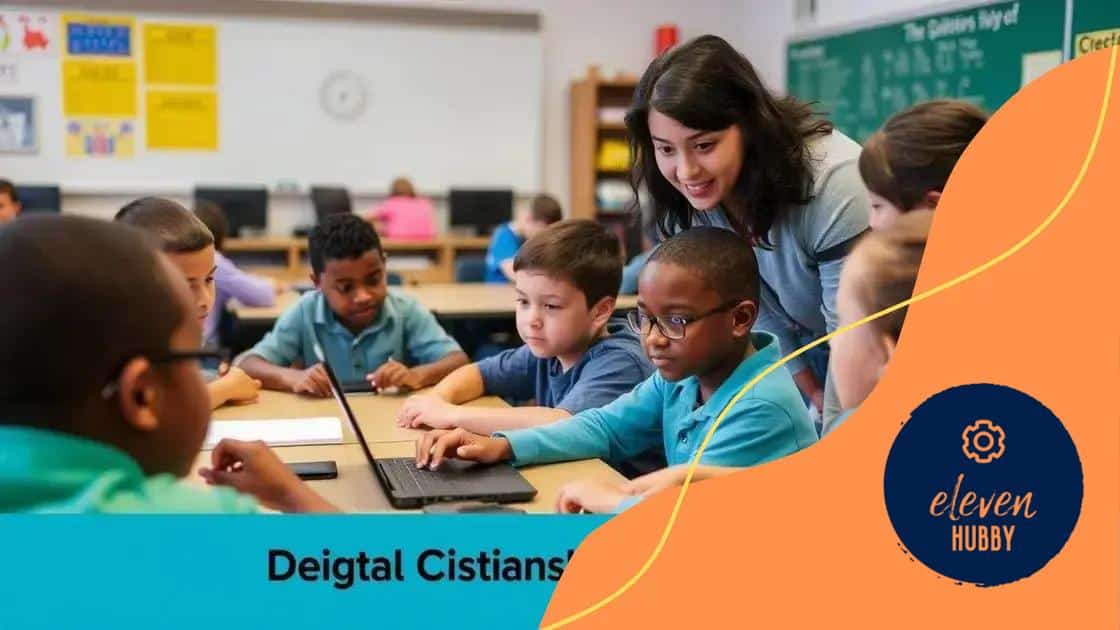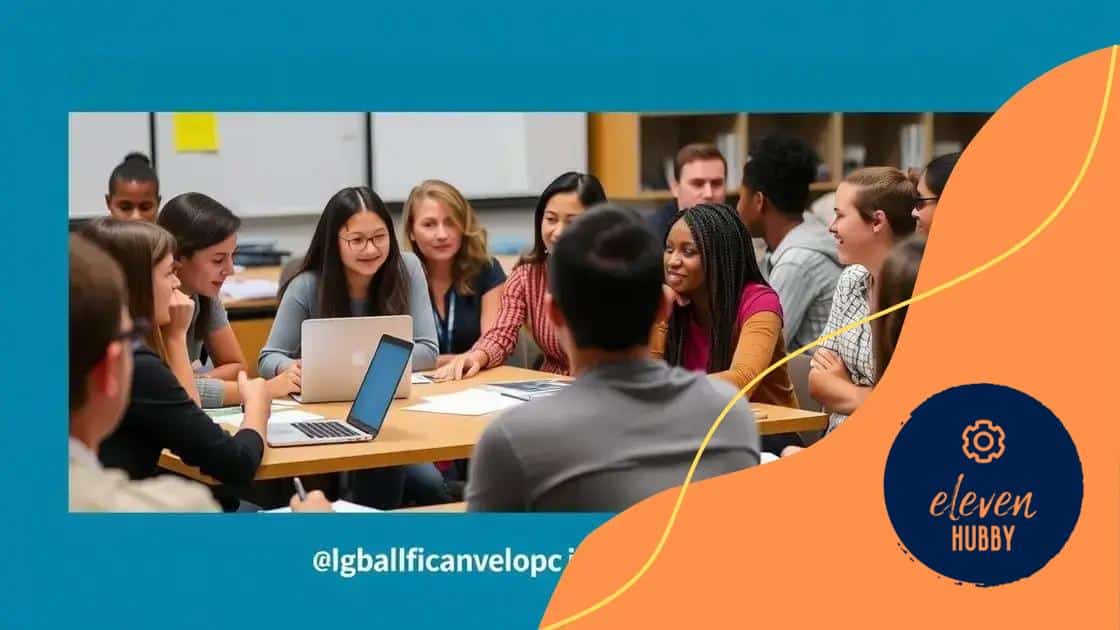The importance of digital citizenship education in schools

The importance of digital citizenship education in schools lies in equipping students with essential skills to navigate online spaces responsibly, promoting safety, critical thinking, and ethical behavior in a digital world.
The importance of digital citizenship education in schools is growing as technology becomes ever-present in students’ lives. Have you ever thought about how digital skills shape their future? In this article, we will explore why this education is vital in today’s digital age.
Understanding digital citizenship
Understanding digital citizenship is essential in today’s technology-driven world. It encompasses the responsible use of technology and the internet, promoting safe and respectful participation in online communities. As students engage with the digital landscape, they need the skills to navigate this space wisely.
What is Digital Citizenship?
Digital citizenship refers to the norms of appropriate and responsible behavior with regard to technology use. This concept includes various elements that contribute to positive online experiences. By understanding these components, students can learn to become not only consumers of digital content but also responsible producers.
Key Components of Digital Citizenship
- Digital literacy: Understanding how to find, evaluate, and use information online.
- Online safety: Recognizing potential dangers like cyberbullying and knowing how to protect personal information.
- Ethical behavior: Acting responsibly and respectfully towards others in digital environments.
- Digital footprint: Understanding the permanence of online actions and the impact of a digital reputation.
The journey to becoming a responsible digital citizen involves continuous learning and adaptation. Students must realize that their actions online can have real-life consequences. This understanding fosters a sense of accountability for their behavior in digital spaces.
Furthermore, educators play a crucial role in guiding students through digital citizenship education. By integrating this knowledge into the curriculum, they help students build essential skills, encouraging them to think critically about their actions online. Engaging discussions and real-world scenarios can enrich learning experiences, making them more relatable and impactful.
Incorporating project-based learning can also enhance students’ understanding of digital citizenship. For instance, students can work together on online projects, enhancing their teamwork skills while learning about digital collaboration and communication tools.
Benefits of digital citizenship education
The benefits of digital citizenship education extend far beyond the classroom, preparing students to thrive in a highly connected world. By teaching students how to use technology responsibly, schools equip them with vital skills for their future.
Enhanced Online Safety
One major benefit is improved online safety. Students learn to identify potential threats, such as phishing scams and cyberbullying. This understanding helps them protect their personal information and make safer choices online.
Development of Critical Thinking Skills
Another advantage is the promotion of critical thinking skills. Students assess information sources and learn to distinguish between reliable and unreliable content. This ability to analyze is crucial in a world filled with misinformation.
- Informed Decision-Making: Educated students can make sound decisions regarding their online presence.
- Empathy and Respect: Learning to interact compassionately with others online fosters respectful communication.
- Active Engagement: Engaging with digital content empowers students to contribute positively to the online community.
Furthermore, digital citizenship education encourages responsible digital communication. By learning how to express themselves positively and constructively, students foster a healthy online culture that benefits everyone.
This education also promotes collaboration among students. Working together on digital projects enhances teamwork skills and builds a sense of community. When students collaborate, they share ideas and learn from each other, creating richer learning experiences.
Additionally, digital citizenship education prepares students for future careers. As technology plays a central role in various fields, understanding how to navigate the digital landscape is an essential skill. Employers often look for candidates who demonstrate digital literacy and responsibility.
Key components of effective programs

Understanding the key components of effective programs for digital citizenship education is essential for embedding this knowledge in schools. A well-designed program not only teaches students the necessary skills but also promotes a culture of responsibility and respect in the digital world.
Curriculum Integration
First and foremost, the program should be integrated into the existing curriculum. By embedding digital citizenship education within subjects like language arts, social studies, and technology, students can see its relevance in various contexts.
Secondly, it is crucial to provide professional development for teachers. Training educators to effectively deliver digital citizenship content ensures that they are well-equipped to guide students in navigating online spaces. Teachers should be familiar with the latest digital trends and challenges so they can provide relevant and timely instruction.
Interactive Learning Experiences
Another important component is creating interactive learning experiences. Activities such as role-playing scenarios, discussions, and collaborative projects can engage students actively. This hands-on approach helps students understand complex concepts and practice their skills in a safe environment.
- Peer Collaboration: Working together fosters communication and problem-solving.
- Real-World Applications: Students learn how to apply their knowledge in practical situations.
- Reflection: Encouraging students to reflect on their experiences helps reinforce learning.
Moreover, utilizing technology itself as a tool for learning can enhance engagement. Students can explore various platforms that teach them about responsible online behavior through games, quizzes, and simulations. These resources make learning about digital citizenship fun and relevant, capturing the attention of learners.
Similarly, involving parents and the wider community in these programs is vital. Schools can hold workshops and informational sessions to promote digital citizenship education at home. When families understand these concepts, it reinforces the values taught in school and fosters a more comprehensive approach to online safety.
Challenges in implementing digital citizenship
Implementing digital citizenship education in schools comes with several challenges that educators and administrators must address to make the programs successful. Recognizing these obstacles is the first step in overcoming them.
Lack of Resources
One significant challenge is the lack of resources. Many schools struggle with limited budgets, which can restrict access to technology and training materials. Without proper tools, it becomes difficult for educators to teach important concepts effectively. Schools may also face challenges in obtaining the latest devices or software that facilitate digital learning.
Inadequate Training for Educators
Another challenge is the inadequate training of educators. Teachers may not feel comfortable integrating digital citizenship into their lessons, particularly if they lack experience or training in this area. Continuous professional development is necessary to equip them with the skills to confidently teach these important principles.
- Time Constraints: Educators often have packed schedules, making it difficult to find time to teach digital citizenship principles.
- Resistance to Change: Some educators may be resistant to altering their traditional teaching methods to incorporate digital citizenship.
- Varied Student Needs: Differing levels of digital literacy among students can create disparities in understanding and engagement.
Additionally, parental engagement can be challenging. Not all parents may understand the importance of digital citizenship education, which can hinder reinforcement at home. Schools should strive to involve parents through workshops and newsletters that highlight the need for such education.
Furthermore, some students may display apathy or resistance toward discussions around digital citizenship. It can be challenging to engage students who feel overwhelmed or uninterested in the responsibility that comes with technology use. Therefore, finding creative and engaging methods to present these topics is essential.
Lastly, navigating rapidly changing technology poses a continual challenge. Digital platforms evolve quickly, and what is relevant today may not be relevant tomorrow. Educators must stay informed and adaptable to current trends to provide students with the most pertinent information.
Tools and resources for educators
There are various tools and resources for educators that can support the teaching of digital citizenship. These resources help teachers provide engaging lessons that resonate with students, enhancing their understanding of online behavior and responsibilities.
Online Platforms and Curricula
Many online platforms offer structured curricula tailored for digital citizenship education. Organizations like Common Sense Media provide comprehensive lessons, activities, and assessments designed for various grade levels. These resources help educators introduce key concepts while aligning with educational standards.
Interactive Tools
Additionally, interactive tools can capture students’ interest. Websites like Kahoot! and Quizizz allow teachers to create quizzes and games that make learning fun. These platforms encourage participation and enable students to apply what they learn about digital citizenship in an interactive way.
- Videos and Webinars: Engaging video content can be used to present real-world scenarios related to digital citizenship, sparking discussions.
- Gaming Apps: Some apps simulate online environments, allowing students to practice their skills in a controlled setting.
- Classroom Resources: Printable worksheets and posters can serve as visual reminders of the principles of digital citizenship.
Moreover, teacher communities, such as Edmodo and Google Classroom, offer forums for sharing ideas and resources. Educators can collaborate, exchange tips, and support each other as they work to integrate digital citizenship into their lessons.
Professional development opportunities also play a crucial role. Workshops and training sessions provide educators with the latest information and strategies on teaching digital citizenship effectively. Staying current with trends in technology ensures that teachers are knowledgeable about the challenges their students face online.
Finally, involving parents through resources and workshops can strengthen the efforts made in the classroom. Providing parents with materials to continue the conversation at home reinforces the lessons taught in school.
FAQ – Frequently Asked Questions about Digital Citizenship Education
What is digital citizenship education?
Digital citizenship education teaches students how to use technology responsibly and safely, promoting ethical behavior online.
Why is digital citizenship important in schools?
It prepares students to navigate the digital world wisely, protects their personal information, and helps them develop critical thinking skills.
What are some effective tools for teaching digital citizenship?
Tools such as Common Sense Media, Kahoot!, and interactive online resources help educators engage students and reinforce learning.
How can parents get involved in digital citizenship education?
Parents can attend workshops, access educational materials, and engage in discussions at home to reinforce the principles taught in school.






